MITSUBISHI L200 2004 (in English) Service Manual
Manufacturer: MITSUBISHI, Model Year: 2004, Model line: L200, Model: MITSUBISHI L200 2004Pages: 264, PDF Size: 4.14 MB
Page 41 of 264
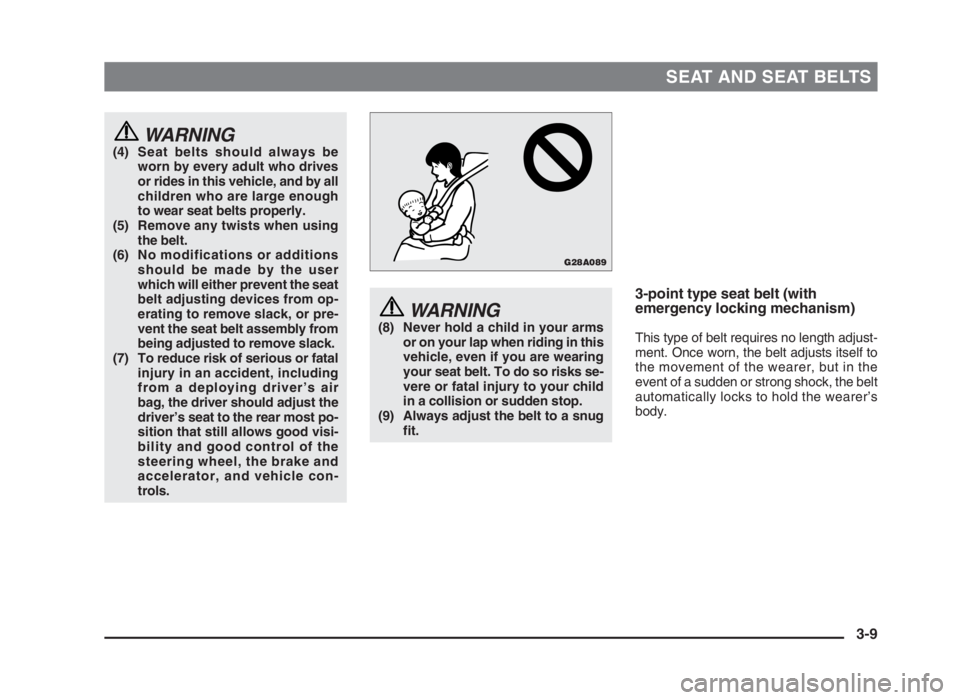
SEAT AND SEAT BELTS
WARNING(4) Seat belts should always be
worn by every adult who drives
or rides in this vehicle, and by all
children who are large enough
to wear seat belts properly.
(5) Remove any twists when using
the belt.
(6) No modifications or additions
should be made by the user
which will either prevent the seat
belt adjusting devices from op-
erating to remove slack, or pre-
vent the seat belt assembly from
being adjusted to remove slack.
(7) To reduce risk of serious or fatal
injury in an accident, including
from a deploying driver’s air
bag, the driver should adjust the
driver’s seat to the rear most po-
sition that still allows good visi-
bility and good control of the
steering wheel, the brake and
accelerator, and vehicle con-
trols.
3-point type seat belt (with
emergency locking mechanism)
This type of belt requires no length adjust-
ment. Once worn, the belt adjusts itself to
the movement of the wearer, but in the
event of a sudden or strong shock, the belt
automatically locks to hold the wearer’s
body.
WARNING(8) Never hold a child in your arms
or on your lap when riding in this
vehicle, even if you are wearing
your seat belt. To do so risks se-
vere or fatal injury to your child
in a collision or sudden stop.
(9) Always adjust the belt to a snug
fit.
3-9
G28A089
03engL2_240082_4 22-01-2004 13:01 Page 3-9
Page 42 of 264
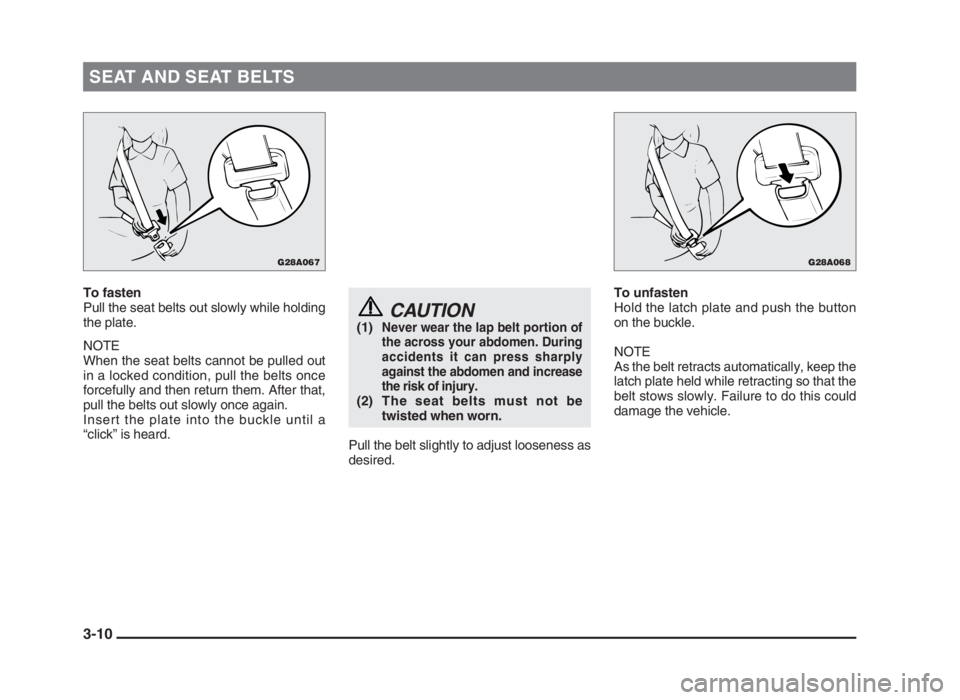
SEAT AND SEAT BELTS
To fasten
Pull the seat belts out slowly while holding
the plate.
NOTE
When the seat belts cannot be pulled out
in a locked condition, pull the belts once
forcefully and then return them. After that,
pull the belts out slowly once again.
Insert the plate into the buckle until a
“click” is heard.
CAUTION(1)Never wear the lap belt portion of
the across your abdomen. During
accidents it can press sharply
against the abdomen and increase
the risk of injury.
(2) The seat belts must not be
twisted when worn.
Pull the belt slightly to adjust looseness as
desired.
To unfasten
Hold the latch plate and push the button
on the buckle.
NOTE
As the belt retracts automatically, keep the
latch plate held while retracting so that the
belt stows slowly. Failure to do this could
damage the vehicle.
3-10
G28A068G28A067
03engL2_240082_4 22-01-2004 13:01 Page 3-10
Page 43 of 264
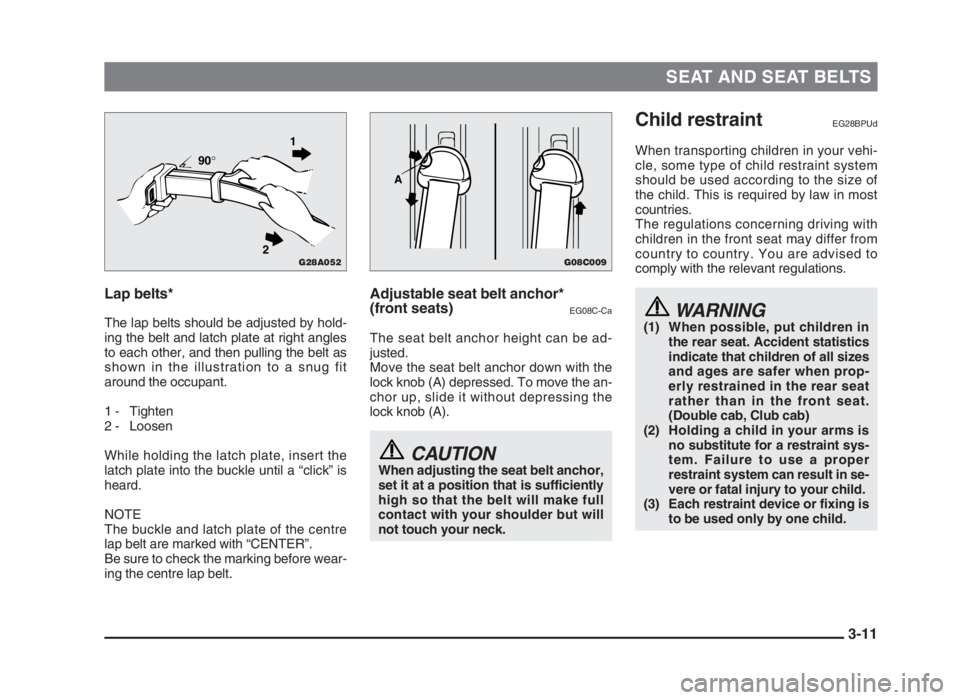
SEAT AND SEAT BELTS
Lap belts*
The lap belts should be adjusted by hold-
ing the belt and latch plate at right angles
to each other, and then pulling the belt as
shown in the illustration to a snug fit
around the occupant.
1 - Tighten
2 - Loosen
While holding the latch plate, insert the
latch plate into the buckle until a “click” is
heard.
NOTE
The buckle and latch plate of the centre
lap belt are marked with “CENTER”.
Be sure to check the marking before wear-
ing the centre lap belt.
Child restraintEG28BPUd
When transporting children in your vehi-
cle, some type of child restraint system
should be used according to the size of
the child. This is required by law in most
countries.
The regulations concerning driving with
children in the front seat may differ from
country to country. You are advised to
comply with the relevant regulations.
WARNING(1) When possible, put children in
the rear seat. Accident statistics
indicate that children of all sizes
and ages are safer when prop-
erly restrained in the rear seat
rather than in the front seat.
(Double cab, Club cab)
(2) Holding a child in your arms is
no substitute for a restraint sys-
tem. Failure to use a proper
restraint system can result in se-
vere or fatal injury to your child.
(3) Each restraint device or fixing is
to be used only by one child.
Adjustable seat belt anchor*
(front seats)
EG08C-Ca
The seat belt anchor height can be ad-
justed.
Move the seat belt anchor down with the
lock knob (A) depressed. To move the an-
chor up, slide it without depressing the
lock knob (A).
CAUTIONWhen adjusting the seat belt anchor,
set it at a position that is sufficiently
high so that the belt will make full
contact with your shoulder but will
not touch your neck.
3-11
G28A052
90°1
2
G08C009
A
03engL2_240082_4 22-01-2004 13:01 Page 3-11
Page 44 of 264
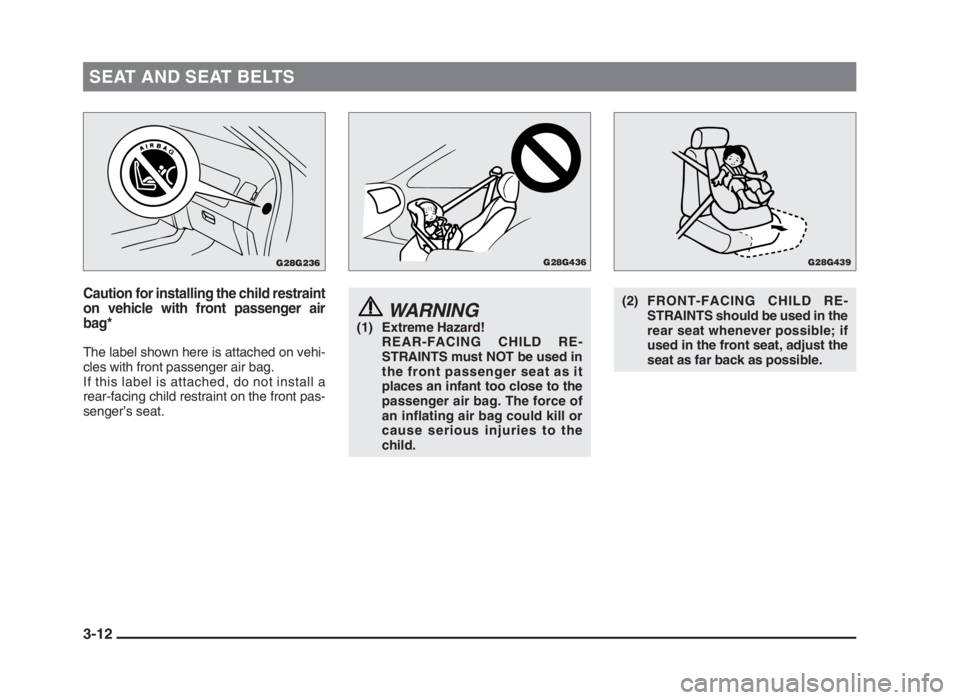
SEAT AND SEAT BELTS
Caution for installing the child restraint
on vehicle with front passenger air
bag*
The label shown here is attached on vehi-
cles with front passenger air bag.
If this label is attached, do not install a
rear-facing child restraint on the front pas-
senger’s seat.
WARNING(1) Extreme Hazard!
REAR-FACING CHILD RE-
STRAINTS must NOT be used in
the front passenger seat as it
places an infant too close to the
passenger air bag. The force of
an inflating air bag could kill or
cause serious injuries to the
child.
(2) FRONT-FACING CHILD RE-
STRAINTS should be used in the
rear seat whenever possible; if
used in the front seat, adjust the
seat as far back as possible.
3-12
G28G439G28G436G28G236
03engL2_240082_4 22-01-2004 13:01 Page 3-12
Page 45 of 264
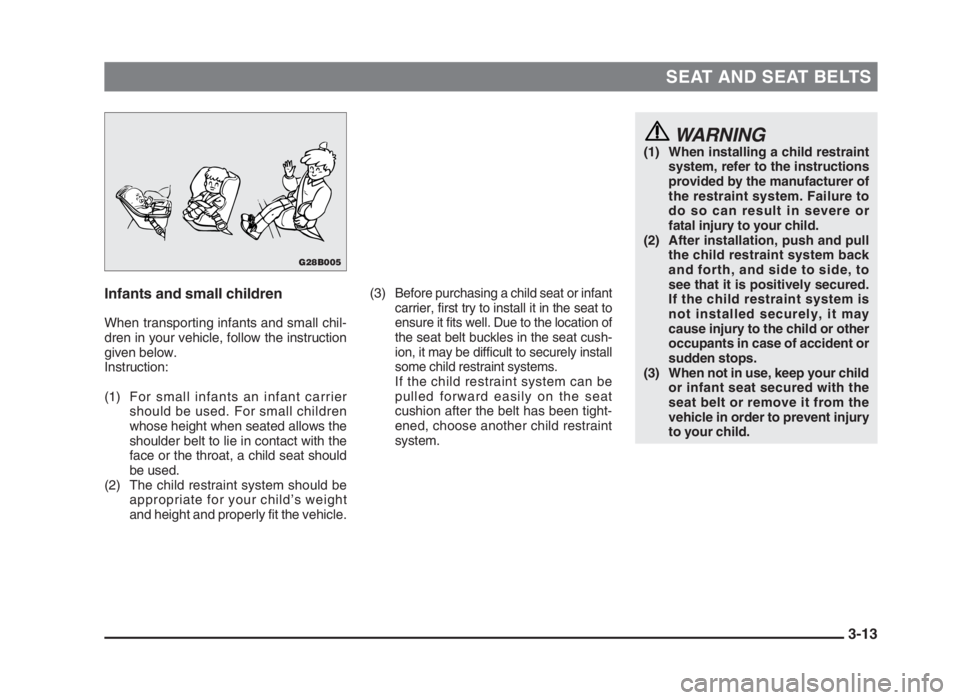
SEAT AND SEAT BELTS
Infants and small children
When transporting infants and small chil-
dren in your vehicle, follow the instruction
given below.
Instruction:
(1) For small infants an infant carrier
should be used. For small children
whose height when seated allows the
shoulder belt to lie in contact with the
face or the throat, a child seat should
be used.
(2) The child restraint system should be
appropriate for your child’s weight
and height and properly fit the vehicle.
WARNING(1) When installing a child restraint
system, refer to the instructions
provided by the manufacturer of
the restraint system. Failure to
do so can result in severe or
fatal injury to your child.
(2) After installation, push and pull
the child restraint system back
and forth, and side to side, to
see that it is positively secured.
If the child restraint system is
not installed securely, it may
cause injury to the child or other
occupants in case of accident or
sudden stops.
(3) When not in use, keep your child
or infant seat secured with the
seat belt or remove it from the
vehicle in order to prevent injury
to your child.
(3)Before purchasing a child seat or infant
carrier, first try to install it in the seat to
ensure it fits well. Due to the location of
the seat belt buckles in the seat cush-
ion, it may be difficult to securely install
some child restraint systems.
If the child restraint system can be
pulled forward easily on the seat
cushion after the belt has been tight-
ened, choose another child restraint
system.
3-13
G28B005
03engL2_240082_4 22-01-2004 13:01 Page 3-13
Page 46 of 264
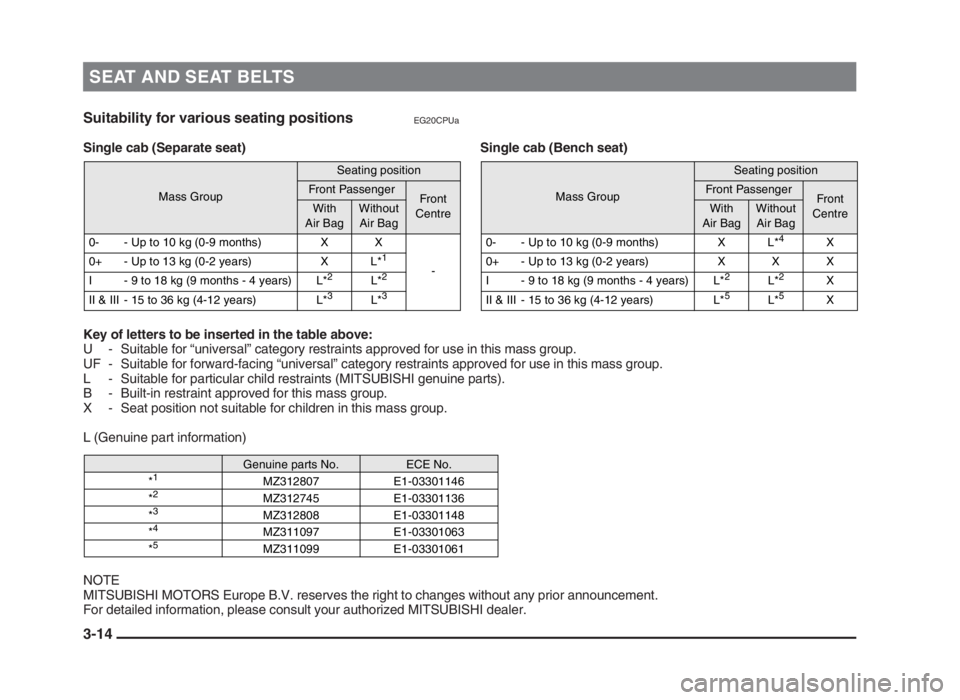
SEAT AND SEAT BELTS
3-14
Key of letters to be inserted in the table above:
U - Suitable for “universal” category restraints approved for use in this mass group.
UF - Suitable for forward-facing “universal” category restraints approved for use in this mass group.
L - Suitable for particular child restraints (MITSUBISHI genuine parts).
B - Built-in restraint approved for this mass group.
X - Seat position not suitable for children in this mass group.
L (Genuine part information)
NOTE
MITSUBISHI MOTORS Europe B.V. reserves the right to changes without any prior announcement.
For detailed information, please consult your authorized MITSUBISHI dealer.
Genuine parts No.
ECE No.
*
1
MZ312807 E1-03301146
*
2
MZ312745 E1-03301136
*
3
MZ312808 E1-03301148
*
4
MZ311097 E1-03301063
*
5
MZ311099 E1-03301061
Suitability for various seating positionsEG20CPUa
Single cab (Separate seat)Single cab (Bench seat)
Mass Group
Seating position
Front PassengerFront
CentreWith
Air BagWithout
Air Bag
0- - Up to 10 kg (0-9 months) X X
- 0+ - Up to 13 kg (0-2 years) X L*
1
I - 9 to 18 kg (9 months - 4 years) L*
2
L*
2
II & III - 15 to 36 kg (4-12 years) L*
3
L*
3
Mass Group
Seating position
Front PassengerFront
CentreWith
Air BagWithout
Air Bag
0- - Up to 10 kg (0-9 months) X L*
4
X
0+ - Up to 13 kg (0-2 years) X X X
I - 9 to 18 kg (9 months - 4 years) L*
2
L*
2
X
II & III - 15 to 36 kg (4-12 years) L*
5
L*
5
X
03engL2_240082_4 22-01-2004 13:01 Page 3-14
Page 47 of 264
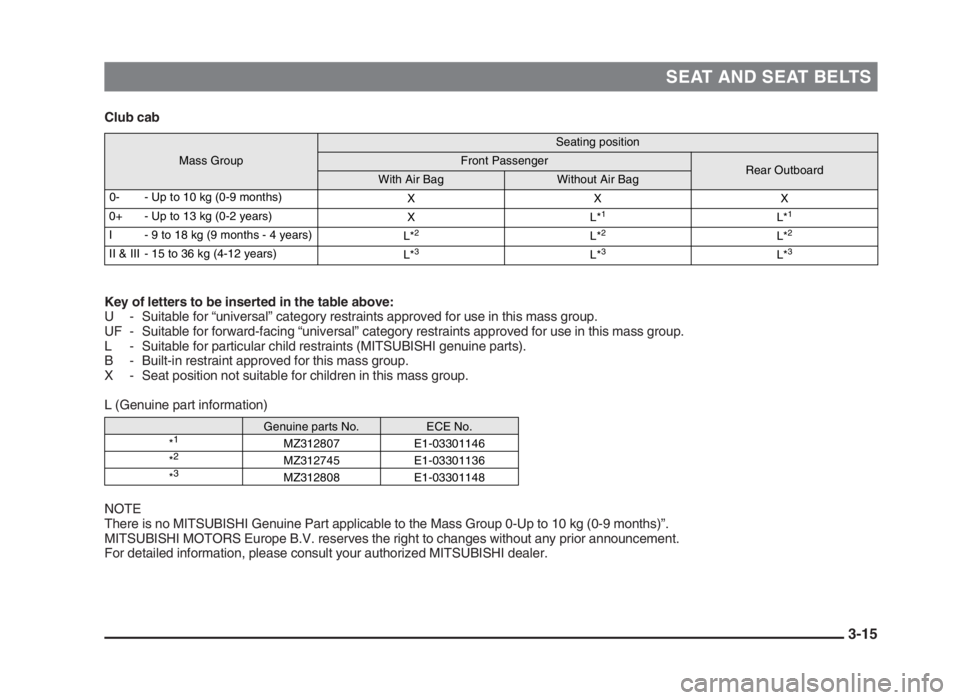
SEAT AND SEAT BELTS
3-15
Club cab
Key of letters to be inserted in the table above:
U - Suitable for “universal” category restraints approved for use in this mass group.
UF - Suitable for forward-facing “universal” category restraints approved for use in this mass group.
L - Suitable for particular child restraints (MITSUBISHI genuine parts).
B - Built-in restraint approved for this mass group.
X - Seat position not suitable for children in this mass group.
L (Genuine part information)
NOTE
There is no MITSUBISHI Genuine Part applicable to the Mass Group 0-Up to 10 kg (0-9 months)”.
MITSUBISHI MOTORS Europe B.V. reserves the right to changes without any prior announcement.
For detailed information, please consult your authorized MITSUBISHI dealer.
Mass Group
Seating position
Front PassengerRear OutboardWith Air BagWithout Air Bag
0- - Up to 10 kg (0-9 months)
XXX
0+ - Up to 13 kg (0-2 years)
XL*
1
L*
1
I - 9 to 18 kg (9 months - 4 years)
L*
2
L*
2
L*
2
II & III - 15 to 36 kg (4-12 years)
L*
3
L*
3
L*
3
Genuine parts No.ECE No.
*1MZ312807 E1-03301146
*2MZ312745 E1-03301136
*3MZ312808 E1-03301148
03engL2_240082_4 22-01-2004 13:01 Page 3-15
Page 48 of 264
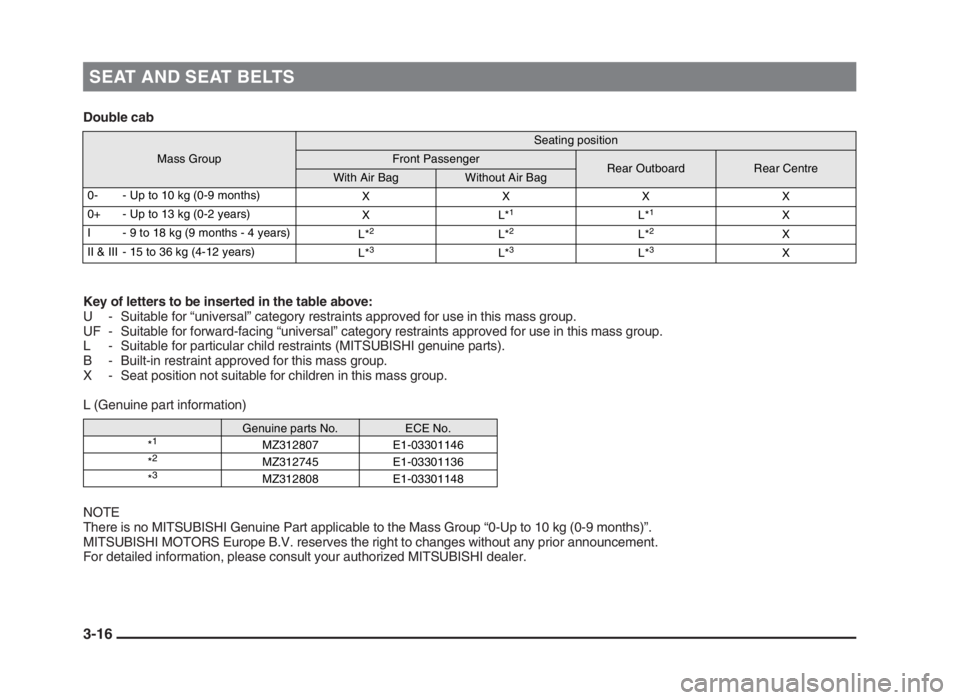
Double cab
Key of letters to be inserted in the table above:
U - Suitable for “universal” category restraints approved for use in this mass group.
UF - Suitable for forward-facing “universal” category restraints approved for use in this mass group.
L - Suitable for particular child restraints (MITSUBISHI genuine parts).
B - Built-in restraint approved for this mass group.
X - Seat position not suitable for children in this mass group.
L (Genuine part information)
NOTE
There is no MITSUBISHI Genuine Part applicable to the Mass Group “0-Up to 10 kg (0-9 months)”.
MITSUBISHI MOTORS Europe B.V. reserves the right to changes without any prior announcement.
For detailed information, please consult your authorized MITSUBISHI dealer.
SEAT AND SEAT BELTS
3-16
Mass Group
Seating position
Front PassengerRear OutboardRear CentreWith Air BagWithout Air Bag
0- - Up to 10 kg (0-9 months)
XXXX
0+ - Up to 13 kg (0-2 years)
XL*
1L*1X
I - 9 to 18 kg (9 months - 4 years)
L*2L*2L*2X
II & III - 15 to 36 kg (4-12 years)
L*3L*3L*3X
Genuine parts No.
ECE No.
*
1
MZ312807 E1-03301146
*
2
MZ312745 E1-03301136
*
3
MZ312808 E1-03301148
03engL2_240082_4 22-01-2004 13:01 Page 3-16
Page 49 of 264
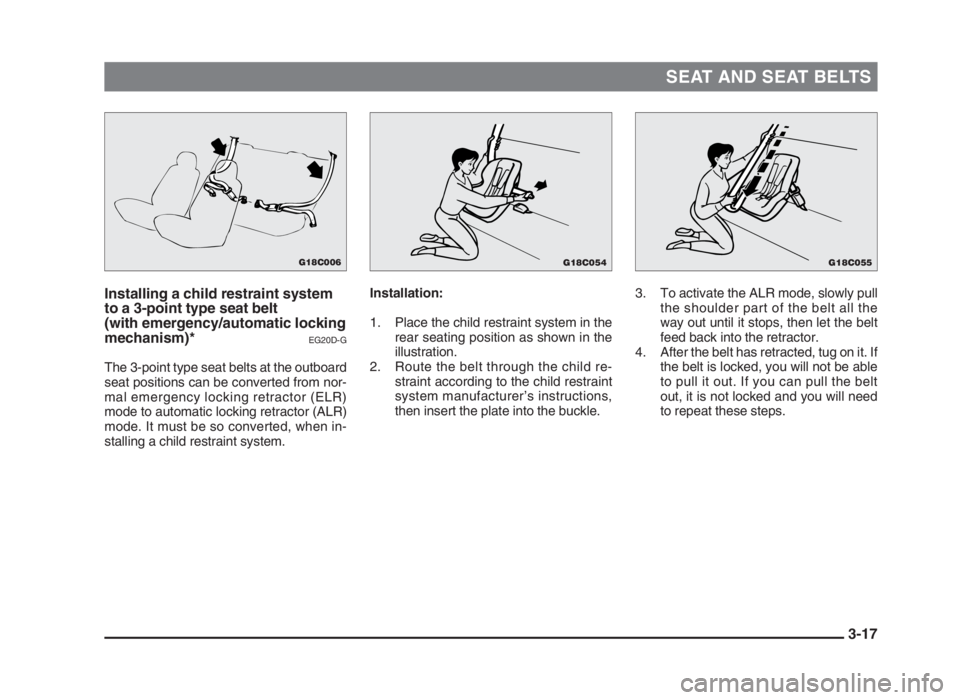
SEAT AND SEAT BELTS
3-17 Installing a child restraint system
to a 3-point type seat belt
(with emergency/automatic locking
mechanism)*
EG20D-G
The 3-point type seat belts at the outboard
seat positions can be converted from nor-
mal emergency locking retractor (ELR)
mode to automatic locking retractor (ALR)
mode. It must be so converted, when in-
stalling a child restraint system.3. To activate the ALR mode, slowly pull
the shoulder part of the belt all the
way out until it stops, then let the belt
feed back into the retractor.
4. After the belt has retracted, tug on it. If
the belt is locked, you will not be able
to pull it out. If you can pull the belt
out, it is not locked and you will need
to repeat these steps. Installation:
1. Place the child restraint system in the
rear seating position as shown in the
illustration.
2. Route the belt through the child re-
straint according to the child restraint
system manufacturer’s instructions,
then insert the plate into the buckle.
G18C054G18C006G18C055
03engL2_240082_4 22-01-2004 13:01 Page 3-17
Page 50 of 264
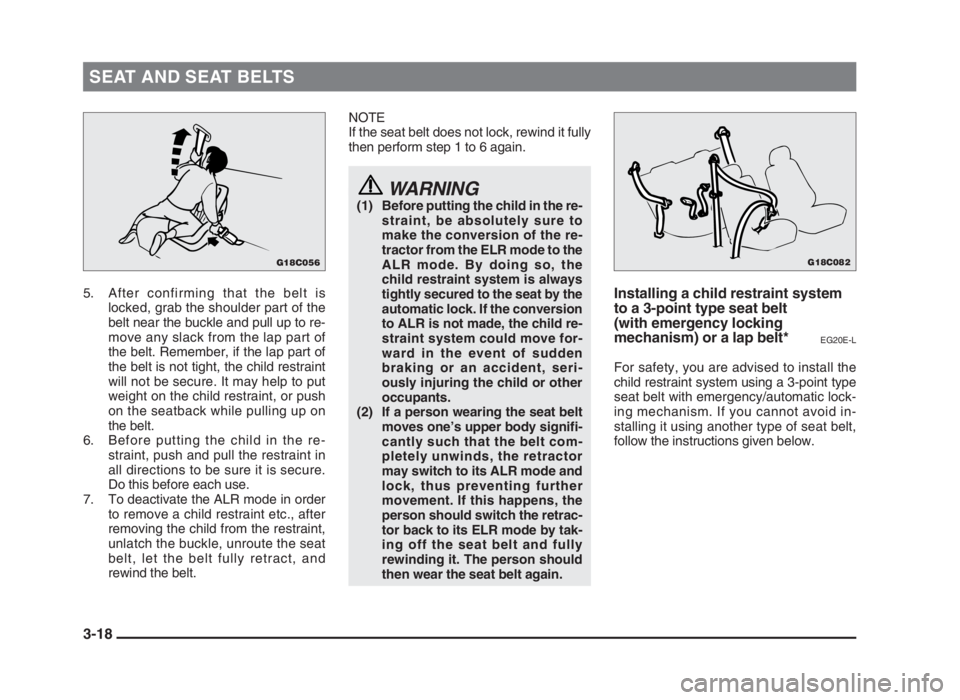
SEAT AND SEAT BELTS
3-18
5. After confirming that the belt is
locked, grab the shoulder part of the
belt near the buckle and pull up to re-
move any slack from the lap part of
the belt. Remember, if the lap part of
the belt is not tight, the child restraint
will not be secure. It may help to put
weight on the child restraint, or push
on the seatback while pulling up on
the belt.
6. Before putting the child in the re-
straint, push and pull the restraint in
all directions to be sure it is secure.
Do this before each use.
7. To deactivate the ALR mode in order
to remove a child restraint etc., after
removing the child from the restraint,
unlatch the buckle, unroute the seat
belt, let the belt fully retract, and
rewind the belt.NOTE
If the seat belt does not lock, rewind it fully
then perform step 1 to 6 again.
WARNING(1) Before putting the child in the re-
straint, be absolutely sure to
make the conversion of the re-
tractor from the ELR mode to the
ALR mode. By doing so, the
child restraint system is always
tightly secured to the seat by the
automatic lock. If the conversion
to ALR is not made, the child re-
straint system could move for-
ward in the event of sudden
braking or an accident, seri-
ously injuring the child or other
occupants.
(2) If a person wearing the seat belt
moves one’s upper body signifi-
cantly such that the belt com-
pletely unwinds, the retractor
may switch to its ALR mode and
lock, thus preventing further
movement. If this happens, the
person should switch the retrac-
tor back to its ELR mode by tak-
ing off the seat belt and fully
rewinding it. The person should
then wear the seat belt again.
Installing a child restraint system
to a 3-point type seat belt
(with emergency locking
mechanism) or a lap belt*
EG20E-L
For safety, you are advised to install the
child restraint system using a 3-point type
seat belt with emergency/automatic lock-
ing mechanism. If you cannot avoid in-
stalling it using another type of seat belt,
follow the instructions given below.
G18C056G18C082
03engL2_240082_4 22-01-2004 13:01 Page 3-18